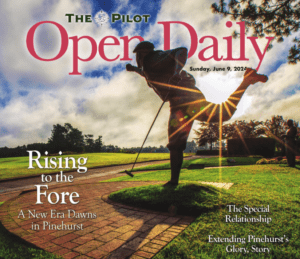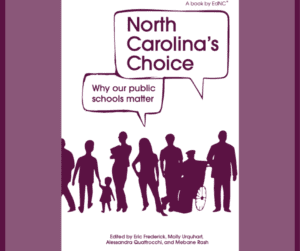Check out the full NC Local newsletter from March 24, including details about the new, foundation-funded Border Belt Reporting Center in Whiteville, a few new media job postings, and links to the upcoming Collaborative Journalism Summit hosted by the Center for Cooperative Media. Sign up to get NC Local in your inbox weekly.
By Eric Frederick, NC Local newsletter editor


‘We all have our blind spots. There are a lot of things that we don’t even know we don’t know. And I would hope that everyone is open to critiquing their own assumptions and biases, and working on them. And I think if we all do that together, and if newsrooms really make good on their DEI initiatives, we’re going to be in a much better place in five to 10 years.’
That’s Waliya Lari of Raleigh, director of programs and partnerships for the Asian American Journalists Association. She came to North Carolina in 2013 and spent four and a half years as a news executive producer for WRAL after working years in journalism in Texas, her home state, and in Oklahoma. She joined the AAJA staff this year.
After the tragedy in Atlanta eight days ago, which raised many issues about bias in coverage of Asian American and Pacific Islander communities, I got to chat with Lari. She talked about the challenges that face AAPI journalists, and what AAPI communities need from the media. Some of her insights, edited for length:
On the experience of AAPI journalists:
AAJA had a mental health session already scheduled the night after Atlanta, and it was “about personal emotions — the shock, the anger, the sadness, the grief,” Lari said. “And then we had another session on Sunday, and it was more focused on, ‘I’m an Asian American in my newsroom; how do I get our managers to listen and to understand that I have a powerful perspective, that these are important stories,’ and the walls that they keep running into. And sometimes the self-doubt that you have is, ‘Is this story that I’m pitching something that is legitimately or objectively a good story, or is it because I’m in that community?’
“These things aren’t going to go away … so how can we stand up this type of support for journalists — that not only are they OK within themselves, because this work brings trauma … but make sure they’re empowered in their newsrooms, because this is your moment — the reason you’re here is to represent your community, to bring stories and sources and details to light that the newsroom may not have without you.
“But in many newsrooms the DEI aspect happens in the hiring. And once that hiring is done, it’s like, ‘OK, here’s how we do things in this newsroom. Conform to it, please.’ As opposed to evolving to reflect the changing demographics and the changing cultures of their community in general. I was thinking about the Raleigh-Durham market, and there is such a huge Asian community here, but you would never know it by walking into any of our newsrooms. And I think: What are they missing?”
About the flip side — whether AAPI journalists feel pigeonholed:
I think there’s two issues there. One is that you don’t want to be just the ethnic reporter. I was on a panel with somebody and they put it a really good way: She was a health reporter, she was also Muslim, and she was like: When I do a story on diabetes, I don’t go find the diabetic in the newsroom and ask them, ‘Hey, can you tell me about diabetics, and diabetes?’ So why is it on me to do that for our newsroom?
“And then the other issue — we saw this in the last week — is this idea that you can’t cover the story properly because ‘you’re from the community, so you’re biased. And so we’re going to just put you to the side, even though you speak the language that we need.’ … I have toddlers, and what they talk about in tantrum management is that when you’re not in a tantrum, that’s when you talk about how you manage feelings, right? I think the same thing has to happen in these discussions in newsrooms — when we’re not covering the breaking news, when we’re not in the middle of the crisis, what conversations are we having about our communities and how we’re covering them?”
On what newsrooms can do this minute:
“Question the official narrative. I think that’s been a huge issue in the last week. Yes, officials are saying one thing, but what of the people who are living and breathing this; what do they feel? OK, well it was about a sexual addiction — does that mean it can’t also be racist? … We’re kind of trained to just accept the official narrative, but I think that you need to treat the stories of the people who are living the experience as also an official narrative…
“And I think the other thing is to consciously ask yourself: Am I bringing assumptions to the table, into the writing, into the framing of my story? And one example that I won’t forget was a shooting in California a couple of years ago. There was this list of attributes that were given to the suspect — oh, he visited Pakistan in the last few years, he made a pilgrimage to Mecca — and I said, ‘You know what? I’ve done all of those things. Are you implying that I’m a terrorist?’
“And I think another question is, who are we not hearing from? Let’s take a step back; there are a lot of loud voices, but who are we not hearing from that’s important, and how can we reach out for those perspectives and include them in the story?”
On what newsrooms can do in the longer term:
“This goes back to building trust between communities and newsrooms, which is being really transparent on how you tell stories and transparent on how community members can contact you, so you’re listening. There’s this heightened awareness suddenly of Asian American communities, and that shouldn’t go away in the next two weeks. How do you continue listening to that part of the community that maybe you’ve neglected?
“If you don’t have someone in your newsroom who is bringing (the daily AAPI experience) up to you, maybe there’s someone in the community that you can connect with. Community brownbag lunches would be great. You can hold virtual community town halls. It doesn’t take very much — just making sure that you’re leaving the walls of your newsroom, just to survey and listen and hear what’s going on, when it’s not an emergency.”
On what AAPI journalists can do now:
“Depending on where you work, many people tend to be the only Asian journalist, either in that newsroom or in that meeting. And it’s that idea of having to convince a roomful of people that what you’re saying is valid. And that’s hard. And it’s the small things, right? It’s the words. One day out of frustration I wrote this blog post that I think RTDNA posted that was about how the words that we use matter, and I made a list — I had Man A and Man B, and I listed a bunch of characteristics. One of them was my husband, and one of them was a recent suspect in a mass shooting who was labeled an extremist. And I said, ‘Please tell me which one is the extremist and which one is my husband.’ And it was difficult.
“The point is that there’s so many loaded terms, that if you’re not from that community you take for granted. And to convince your co-workers to stop using that terminology, even though everyone else is using it, is very difficult… But you just have to fight, little by little, and chip away, and I like to think that every time I’ve spoken up I’ve made a dent in someone’s thinking that can stick with them, and then they can take that along to their other spheres of influence and have this ripple effect … And I think we’re on our way. It’s just, keep chugging forward and not burn out.”
Resources, tips, ways to get involved
◼️ How to support the AAPI community in a time of hate and violence: A Resource List. A great information portal, put together by independent journalist Sarah Belle Lin.
◼️ AAJA Encourages Newsrooms to Empower AAPI Journalists and Their Expertise. A call to action from the AAJA Broadcast Advisory Council.
◼️ In case you missed it, here’s the AAJA guidance to newsrooms after the Atlanta tragedy.
◼️ The AAJA Studio can help you diversify your sources with AAPI researchers and thought leaders.
◼️ You can join AAJA as a student, professional or ally … You can donate to (or apply for) the AAPI Journalists Therapy Relief Fund … AAJA is offering financial help for students doing summer internships; apply by April 22.
◼️ Support other AAPI organizations, such as Asian Americans Advancing Justice and Stop AAPI Hate.
◼️ Nicole Cardoza’s Anti-Racism Daily newsletter [subscribe] is always timely and topical, and she shares her space with diverse voices, many of them AAPI. Her call to support local journalism Monday was, as usual, one we can endorse. … Videos on her Instagram channel are always an enlightening place to spend a half-hour.
On understanding the issues
Some illuminating reads I’ve found in the past week:
➡️ “(Dehumanization of Asian American women that reduces them to sexual objects) coupled with the pervasiveness of the ‘model minority myth,’ which seeks to drive a wedge between minority groups and treats the Asian American experience as an exceptional and homogenous one, renders the pain and violence that Asian American women endure invisible.” The Atlanta shootings can’t be divorced from racism and misogyny. Li Zhou, Vox.
➡️ “We’ve seen these Asian Americans work very, very hard, diligently. They’ve trusted American systems and believed in the order set forth for them to succeed. And then, you see their lives cut short.” A quote from To be Asian and Atlantan right now, by Simi Shah, URL Media.
➡️ “The media can tell us that the women who were murdered were Asian, and that they worked in massage parlors. White supremacy, classism, and patriarchy tell us to interpret those facts to mean that they were sex workers—and that sex work somehow plays a role in their deaths. The assumption speaks to the ways we fail to see women—especially working class women of color—beyond the roles, tropes, and stereotypes to which we’ve relegated them, whether China Doll or Mammy.” Ending white supremacist violence will take all of us. Cierra Hinton, Scalawag’s executive director-publisher.
On best practices for media
➡️ “Are we quoting the police because we think that protects us? Are we getting as many sides of the story as we can even as the story evolves? … Journalists have the power to shape public perception, so it’s our job to dig deeper into the suspect’s motives, to let our audience know more about the victims and their lives, to talk to other people who were affected — including witnesses and victims’ families.” The rush to report on Atlanta-area shootings amplified bias in news coverage. Doris Truong, Poynter.
➡️ “The work of AAPI women journalists — spanning decades and even centuries — has continuously centered AAPI communities’ experiences, perspectives and information needs. They have pushed the entire journalism industry forward by demonstrating how to center and serve those who have been historically excluded by the media.” Why we’re urging funders to support AAPI women’s leadership in journalism now. Lea Trusty, program associate at Democracy Fund, for the Engaged Journalism Lab.
➡️ “If you want meaningful engagement, connections and nuanced storytelling, let journalists with lived experiences lead on all levels in the newsroom.” 5 Things I Learned as an AAPI Engagement Editor Covering Anti-Asian Hate. Kristine Villanueva, Nieman Reports.




